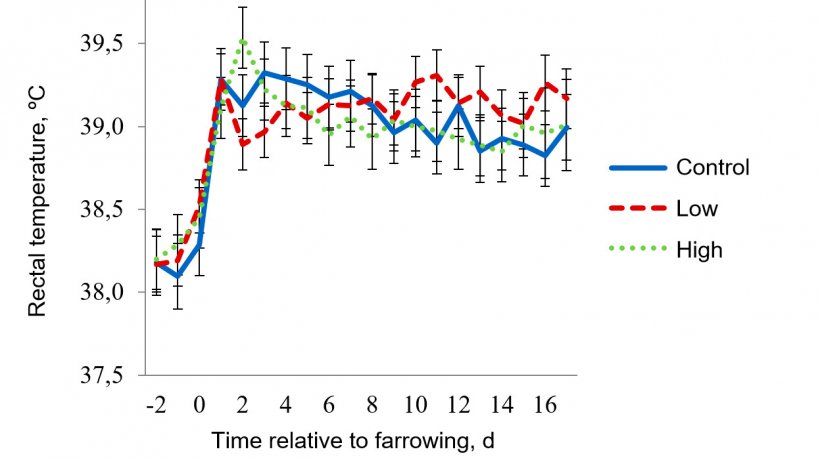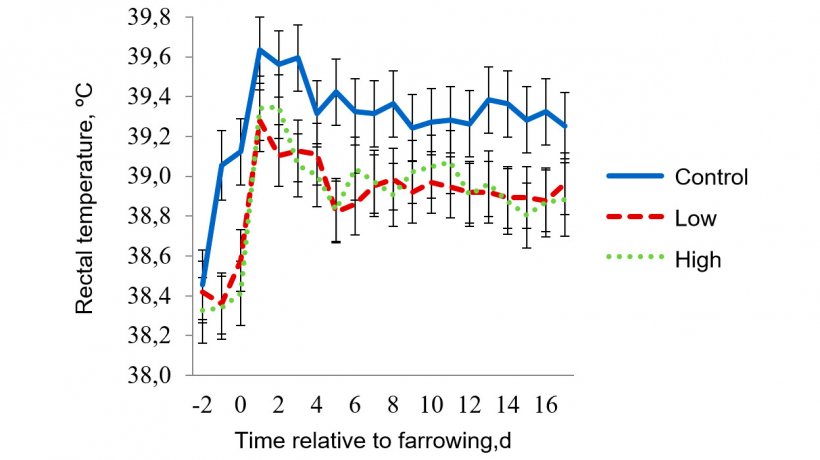热应激对母猪生产力和繁殖性能均有负面影响。其对动物新陈代谢和生理有多重影响,包括:增加身体的中心温度,增加到皮肤的血液流量以消散辐射热,提高呼吸率以消除多余的热量,以及减少采食量,从而减少产热量。故热应激的母猪会减少产奶量和仔猪增重量。泌乳期内体内蛋白质损失过多的母猪断奶到发情间期增长,受孕率降低。
在过去的三十年中,持续选择增加产仔数和产奶量增加了母猪的产热量并降低其上限临界温度。 这种选择还导致仔猪出生体重下降,出生时体内能量储备减少,产房需要更高的室温以及使用加热垫或加热灯为仔猪提供局部热量。

普渡大学动物科学和农业生物工程系和美国农业部研究所(USDA-ARS)家畜行为研究中心在过去三年一直在合作开发一种能有效消除泌乳母猪过量热量的冷却垫。
地板冷却是基于当动物躺卧时,从热源(动物)到水槽(通过管道流动的冷水)的热量传导。铝和铜能够在两种温度之间有效传递热量。散热垫的表面使用了重型铝板,高密度聚乙烯底座和连接在铝板上的铜制水管(图1)。在这些初始测试中,扩大了冷却垫的尺寸,并且对不同环境条件下的恒定流速范围,冲洗间隔期和期望的上限设定温度进行了改进。

图1- Purdue生猪冷却垫的当前原型
将改进的冷却垫设计用于母猪泌乳试验中,如图2所示。与使用冷却垫的母猪相比,未使用冷却垫的母猪保持“狗卧式”姿势的时间更长以增加身体向环境的散热,进食时间短,且喂奶时间短。 冷却80分钟后,与未使用冷却垫的母猪相比,使用冷却垫的母猪表现出更低的呼吸率(45-122次呼吸/分钟),心率(100次比119次/分钟),阴道温度(39.2比40.1℃),直肠温度(39.0比40.0℃)和皮肤温度(38.6比39.4ºC)。散热率比之前由混凝土和钢管制成的覆盖整个地板的冷却垫设计高出三至四倍。

图2 - Purdue冷却垫原型在分娩舍进行测试。
在轻度和中度热应激条件下评估母猪冷却垫对整个泌乳期的有效性。中等热应激猪舍的目标是在在0800-1600点间保持温度为32ºC,而一天的其它时间温度保持在27ºC。轻度热应激猪舍的目标温度在0800-1600点间保持温度为27ºC,而一天的其它时间保持在22ºC。约克夏-长白母猪按胎次和体重分组,并分配到2个仅环境温度不同的产房。每头母猪使用一个八排冷却垫。母猪接受0.00 升/分钟(对照,n = 9),0.25升/分钟(低,n = 12)或0.50(高,n = 10)升/分钟的恒定冷水流。记录进水口和出水口的温度和流量以估计排热量。从进入产房第2天到19天断奶,每天(0700和1500点)记录呼吸率(RR),直肠温度(RT)和皮肤温度(ST)。母猪冷却垫减少了热应激。低流速适用于轻度热应激猪舍,中等热应激猪舍需要高流速。图3和4显示了Purdue猪冷却垫对呼吸率的影响,而图5和6显示了对直肠温度的影响。
| 变量 | 冷却垫处理 | 轻微 – 700 h | 中等 – 700 h | 轻微 – 1500 h | 中等 – 1500 h |
| 呼吸率 | 对照 | 23 | 56 | 41 | 89 |
| 低 | 21 | 24 | 29 | 41 | |
| 高 | 18 | 20 | 24 | 27 | |
| 皮肤温度 | 对照 | 35.4 | 37.3 | 37.2 | 37.3 |
| 低 | 34.4 | 36.5 | 36.6 | 36.5 | |
| 高 | 33.7 | 36.2 | 36.5 | 36.2 | |
| 直肠温度 | 对照 | 38.8 | 39.0 | 39.2 | 39.6 |
| 低 | 38.8 | 38.8 | 39.1 | 39.0 | |
| 高 | 38.8 | 38.8 | 39.1 | 39.0 |

图3 - 轻度热应激猪舍呼吸率的最小二乘平均值。轻度热应激目标温度在0800-1600点为27ºC,其余时间为22ºC。呼吸率受到冷却垫处理,室温(房间),一天中的时间(时间),泌乳日龄以及冷却垫处理×房间,冷却垫处理×时间, 房间×时间相互作用的影响(P <0.001)

图4 – 中度热应激猪舍呼吸率的最小二乘平均值。中度热应激目标温度在0800-1600点为32ºC,其余时间为27ºC。呼吸率受到冷却垫处理垫,室温(房间),一天中的时间(时间),泌乳日龄以及冷却垫处理×房间,冷却垫处理×时间,房间×时间相互作用的影响。


图5 - 轻度热应激猪舍的直肠温度。轻度热应激目标温度从0800-1600小时为27ºC,其余时间为22ºC。一天中的时间,泌乳日龄,冷却垫处理×室温,冷却垫处理×时间,泌乳日龄×室温,冷却垫处理×室温×一天中的时间之间的3向相互作用对母猪直肠温度有影响(P <0.038)。

图6 - 中等热应激猪舍的直肠温度。中度热应激目标温度从0800-1600小时为32ºC,其余时间为27ºC。一天中的时间,泌乳日龄,冷却垫处理×室温,冷却垫处理×时间,泌乳日龄×室温,冷却垫处理×室温×一天中的时间之间的3向相互作用对母猪直肠温度有影响(P <0.038)。
致谢
这项研究由普渡大学资助,作为支持印第安纳州农业和农村发展的AgSEED Crossroads资金的一部分,以及USDA-ARS项目5020-32000-013-00-D - 保护食品生产动物福利。作者还要感谢Daniel Madson和Aaron Doke在开发和改进散热垫设备方面所做的工作。



